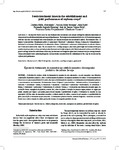Please use this identifier to cite or link to this item:
http://www.alice.cnptia.embrapa.br/alice/handle/doc/1020761| Title: | Seeds treatment times in the establishment and yield performance of soybean crops. |
| Authors: | BRZEZINSKI, C. R.  HENNING, A. A.   ABATI, J.   HENNING, F. A.   FRANÇA-NETO, J. de B.   KRZYZANOWSKI, F. C.   ZUCARELI, C.   |
| Affiliation: | CRISTIAN RAFAEL BRZEZINSKI, UEL; ADEMIR ASSIS HENNING, CNPSO; JULIA ABATI, UEL; FERNANDO AUGUSTO HENNING, CNPSO; JOSE DE BARROS FRANCA NETO, CNPSO; FRANCISCO CARLOS KRZYZANOWSKI, CNPSO; CLAUDEMIR ZUCARELI, UEL. |
| Date Issued: | 2015 |
| Citation: | Journal of Seed Science, v.37, n.2, p.147-153, 2015. |
| Description: | ABSTRACT: The objective was to assess the early treatment effect of soybean seeds and pre-sowing with different combinations of chemicals on the establishment of plants and crop yield performance. The design was in randomized blocks in a 2x7 factorial arrangement, with two times for seed treatment and seven treatments (six chemical treatments and an untreated control). The treatments were: 1) fipronil + pyraclostrobin + thiophanate methyl; 2) imidacloprid + thiodicarb + carbendazin + thiram; 3) abamectin + thiamethoxam + fludioxonil + mefenoxam + thiabendazole; 4) carbendazin + thiram; 5) fludioxonil + mefenoxam + thiabendazole; 6) carboxin + thiram; and 7) untreated control (water only). The assessments were: seedling emergence, final stand, plant height and insertion of first pod, number of pods per plant, seeds per pod and per plant, thousand-seed weight and grain yield. Early treatment of soybean seeds (240 days prior to sowing) hinders the establishment of the crop, the thousand-seed weight and grain yield in relation to the pre-sowing treatment. Chemical treatments tested containing fungicides and insecticides associated favor the establishment of the crop, but do not alter the soybean yield performance. RESUMO – O objetivo foi avaliar o efeito do tratamento de sementes de soja antecipado e em pré-semeadura com diferentes combinações de produtos químicos, sobre o estabelecimento de plantas e desempenho produtivo da cultura. O delineamento foi de blocos ao acaso, em esquema fatorial 2x7, sendo, duas épocas de tratamento de sementes e sete tratamentos (seis tratamentos químicos e uma testemunha sem tratamento). Os tratamentos foram: 1) fipronil + piraclostrobina + tiofanato metílico; 2) imidacloprido + tiodicarbe + carbendazin + thiram; 3) abamectina + tiametoxan + fludioxonil + mefenoxam + thiabendazole; 4) carbendazin + thiram; 5) fludioxonil + mefenoxam + thiabendazole; 6) carboxin + thiram; e 7) testemunha sem tratamento (somente água). As avaliações foram: emergência de plântulas, estande final, altura de plantas e inserção da primeira vagem, número de vagens por planta, sementes por vagens e por planta, massa de mil sementes e produtividade de grãos. O tratamento de sementes de soja antecipado (240 dias antes da semeadura) prejudica o estabelecimento da cultura, a massa de mil sementes e a produtividade de grãos, em relação ao tratamento em pré-semeadura. Os tratamentos químicos testados contendo fungicidas e inseticidas associados favorecem o estabelecimento da cultura, porém não alteram o desempenho produtivo da soja. |
| Thesagro: | Soja Tratamento de semente Fungicida Inseticida Plântula |
| NAL Thesaurus: | Soybeans Seed treatment Seedling emergence Grain yield |
| Keywords: | Emergêcia |
| DOI: | 10.1590/2317-1545v37n2148363 |
| Type of Material: | Artigo de periódico |
| Access: | openAccess |
| Appears in Collections: | Artigo em periódico indexado (CNPSO)  |
Files in This Item:
| File | Description | Size | Format | |
|---|---|---|---|---|
| 23171537jss370200147.pdf | 711.65 kB | Adobe PDF |  View/Open |









